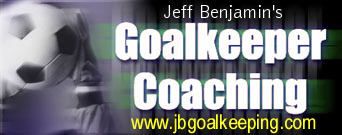
|
"Outstanding keeper instruction. This is a must for goalkeepers and coaches." —Ottawa Internationals S.C. web site, Ottawa, Canada |

|

|
Top |
Goalkeeping Tips, Tidbits and Random Thoughts
An athlete talking to themsleves during competition is hardly a new phenomenon.... The talk does not have to be vocal. By merely thinking you are talking to yourself and sending a message.
-- Tony DiCicco, Goalkeeper Soccer Training Manual
If you have a question, comment or rebuttal you'd like to see addressed here, send me email. I will post your mail to the blog at my discretion unless you specify otherwise.
Play soccer with Pele
The folks at 360 Soccer dug up a copy of an old book written by Pele in 1976: Play Soccer with Pele. It's an interesting read, particularly the chapter on the goalkeeper.Labels: Miscellaneous
Integrating the goalkeeper into team practice
So just how do you go about integrating the goalkeeper into a team practice? Often, if there is a goalkeeper trainer at all, the keepers go off and do their own thing for a while, then suddenly show up just as the team goes into a full-sided game and hop into goal. More usually, the keepers train with the rest of the field players and then hop into goal with no keeper-specific warm-up or instruction at all. Both of these approaches leave the goalkeepers somewhat isolated: either apart from the team, or separating from the team to face shots on goal.It's not an easy problem to solve unless the team coach recognizes the goalkeeper as an important part of the practice from the start, and designs practice sessions with that in mind.
All kinds of games and warm-up activities could be tweaked to include a goalkeeper, and the sooner full goals and goalkeepers are integrated into team games, the more soccer-like the activities are (and the more fun the players have to boot). Here are a few tings you can to in your team practice to include a goalkeeper:
- Passing/receiving warm-ups: Allow goalkeepers to participate and receive balls with their hands (focusing on good ground-ball pickups) and distribute via throws.
- Keep-away games: Add keepers as neutral support players outside the grid, and allow them to field balls and distribute with their hands. Variation: passes to the keepers must be lofted so the keeper catches the ball above the waist.
- Directional small-sided games: Rather than shooting at goals, players must pass the ball to a "target" goalkeeper over the goal line. You can restrict scoring to balls hit to the target keeper at a certain height (ground, chest high, chips higher than head height, etc.). Allow back-passes to the keeper, who can then distribute from the hands.
- "Handball"-type games for the whole team: Obviously the keeper will get more benefit from games involving hand passing, but these types of games are a lot of fun and a good change of pace for the field players as a warm-up or to teach younger players ideas about space and movement.
And of course, if you have access to full-size goals, make use of them as often as possible and get your keeper into the net!
Labels: Training
Isolate the components
When you're learning a new skill, whether it has to do with soccer or not, you usually don't get good at it right away. At first, you have to think hard about what you're doing, so the skill doesn't come naturally or fluidly at first. It's only after you've worked on that skill, and gotten the brain pathways set and the muscle memory activated that you really master things.One way to work through the difficult part of learning a skill is to isolate one component of that skill to focus on. Ignore mistakes in other parts of the skill for a while and work on getting that one element right.
I often do this with keepers who are struggling a bit with new stuff. I present a lot of information, and it's difficult to do everything at once. For example, let's say I'm introducing diving to young keepers. The key coaching points are step forward into the dive, catch the ball with both hands, ball to the ground first, land on hip and shoulder, and pin the ball to the ground with one hand on top of and one behind the ball. Lots of stuff to accomplish in a half second! So if a keeper isn't getting the step, I might tell them: "Let's focus on making that step forward for the next few minutes. I don't care if you catch the ball or not, or about how you land -- just make sure you take that step!" Then, once the step is ingrained, we can move on to the other aspects of the dive.
You can apply this technique to any soccer or non-soccer skill that you are teaching someone. It allows both player and coach to break the skill down into small, easily manageable pieces that the player can succeed at.
Labels: Psychology, Training
Goalkeeper parodies
I find the Guardian Unlimited Football site a good source not just of soccer information, but soccer humor. They have a section entitled The Gallery that features reader's visual renditions of various soccer stars. While goalkeepers don't get that many notices (probably a good thing!), here are a couple of goalkeeper parodies I found particularly amusing:David James
Fabien Barthez
Labels: Miscellaneous
Catching the ball
Poor Tim Howard. He's been Manchester United's number one since going over to England, but United has fallen into a bit of a slump lately. And to be honest, I think I would pin their going out of the Champion's League today in the second leg against Porto at least in part on Howard.The most important thing a goalkeeper can do is be able to catch the ball. That's why they get the funny shirt and gloves. If you're not going to catch the ball -- the goalkeeper's one advantage over 20 other players on the soccer pitch -- you might as well not bother. And for as well as Howard's done, he has an alarming propensity for occasionally slapping at a ball that should be caught, or at worst punched far clear.
The Porto goal, which came in the 90th minute, was one of these. Porto had a free kick from about 25 yards out. It was struck decently, but not perfectly, towards the far upper corner. Howard appeared to have a bead on it, and even got both hands to it, but couldn't hang on and knocked the ball down for an onrushing Porto attacker to slam home -- and slam the door on ManU's CL hopes.
To be fair, it was a decent kick, and Howard may have been unsighted by the mass of players in front of him and gotten a late reaction to the ball. And United didn't have a single defender on the bench to bring in to help defend the one-goal lead. But even the very best goalkeepers have areas that need work. And catching the ball every time should be something all goalkeepers strive for.
Labels: Matchday observations
How to warm up a goalkeeper
Somebody asked about how to warm up a goalkeeper over on the Forum at and-again.com.Goalkeepers do need a warmup different from the team. About the worst thing to do is have them run a lap and then set them in the goal to face unopposed shots from 16 yards out.
After the basic physical warm-up with the team (jogging and other wise loosening up and getting the blood flowing), keepers need to separate and get their hands warmed up with some catch. A coach can do this, or (better yet) have your goalkeepers learn to warm each other up.
I'd start with simple catch, focusing on good catching technique and footwork to get the body behind the ball. Contour catch, then knee-high for basket catches, high balls, and rolling balls. Then do a simple diving progression: sitting, kneeling, squatting, standing. Go from easy collapsed-dive distance, and finish with a few extended dives (but not too many!). I then like to add some quick-hands drills (keeper tosses ball to server who punches it back at them) and a few "mock" breakaways to get the keeper comfortable with coming off their line.
As for punting, I'd leave that up to the individual keeper. Do, however, make sure they have their hamstrings thoroughly warmed and stretched. Finally, if you have a team activity that requires a keeper to face live shots, put them in for a bit.
The training sessions have some activities that can be used for game-day warmups. For example, footwork mirroring and the sit/kneel/stand/squat progression can be found there.
Labels: Training